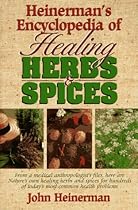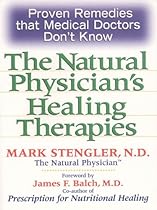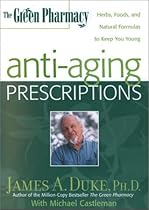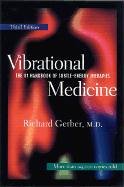| Turmeric is also widely employed in chinese medicine, where it is known as "yellow ginger" (huang jiang). Traditional Chinese doctors use it to treat liver and gallbladder problems. It has many other medical uses: to promote bile secretions, increase appetite, lower blood pressure, alleviate pain and reduce inflammation. A Chinese scientific study even showed that it was "100 percent effective in preventing pregnancy in female rats," according to Dr. A. Leung, in Chinese Herbal Remedies (New York: Phaidon Universe, 1984). The traditional Chinese dose is three to six grams (0.1 to 0.3 oz. |
Michael Lerner
See book keywords and concepts |
 They stressed particularly the value of chinese medicine in coping with the side effects of chemotherapy and radiation.
I have suggested previously that spiritual, psychological, nutritional, and physical approaches to cancer represent a quartet of intrinsically open and ethical approaches to intensive health promotion in the face of cancer. Now I would like to add a fifth key approach to cancer. It differs from the quartet only in that it often contains elements that are not obviously intrinsically health-promoting. This fifth approach is found in the traditional medicines of the world. They stressed particularly the value of chinese medicine in coping with the side effects of chemotherapy and radiation.
I have suggested previously that spiritual, psychological, nutritional, and physical approaches to cancer represent a quartet of intrinsically open and ethical approaches to intensive health promotion in the face of cancer. Now I would like to add a fifth key approach to cancer. It differs from the quartet only in that it often contains elements that are not obviously intrinsically health-promoting. This fifth approach is found in the traditional medicines of the world. |
| Qi In the traditional system of chinese medicine, the vital energy or life force of the body.
Qi gong An ancient Chinese martial art combining movement with meditation and breath awareness which has as one of its goals the conscious control of the body's energetic system.
Randomization A method of minimizing bias in a controlled study, in which all subjects have an equal chance of being assigned to the study group or control group. In this way, all factors which might confound the results of the study can be considered to be equally present in both groups. |
| Kaptchuk, The Web That Has No Weaver: Understanding chinese medicine (New York: Congdon and Weed, 1983), 3-4.
10 J.W. Dundee, "Belfast Experience with P6 Acupuncture Antiemesis," Ulster Medical Journal 59(1):63-70 (1990).
11 D. Stannard, "Pressure Prevents Nausea," Nursing Times 8S(4):33-4 (1989).
12 Eisenberg and Wright, Encounters with Qi, 68-74.
13 Ibid., 74.
14 Ibid., 76-7.
15 T. Kondo, "Studies on the Management of Cancerous Pain of the Head and Neck Region," Jibiinkoka-Rinsho 73(9): 1469-79 (1980).
16 I.A. Frid and D.G. |
| In classic chinese medicine, Hsu says, there is no specific concept of cancer. Some tumors are simply considered more dangerous than others:
Those that can be cured are probably Western medicine's equivalent of a benign tumor. The Chinese have perfected over the years many, many formulas that reduce or arrest swelling and alleviate pain. They have also learned much about nutrition and are extremely aware of the benefits to be derived from nutritive supplementary tonics. These are the medicines that are discussed in this book. |
| What about nutritional approaches? chinese medicine? Stress reduction? Yoga? What about my family? My fears? What about the meaning of all this in my life?
Even if you stay completely within the mainstream of conventional medical approaches, opinions and recommendations can differ considerably in critical areas such as diagnosis, prognosis, and treatment among different physicians and surgeons, different subspecialists, and in different countries. |
| The concept of qi is central to chinese medicine and numerous other traditional medicines. It is the prana of yoga: the vital charged energy of feeling alive that many sensitive people and any moderately regular practitioner of a psychophysiological discipline comes to know as an experiential truth. This qi or prana is often depleted by excesses in the activities of life: excessive sexual intercourse, excessive eating, excessive time in front of the television, excessive work, excessive talking. |
John Boik
See book keywords and concepts |
 In contrast, the formula increased plasma testosterone and lowered plasma estradiol in patients with kidney yin vacuity, a disease pattern in chinese medicine that is common in menopausal women.
Zhang and Zhou, 1991; Zhuetal., 1993
Pimpinella anisum (anise)
Stimulated estrogen production in animals. The active ingredients are thought to be in the essential oils.
Albert-Puleo, 1980
Salvia miltiorrhiza (dan shen)
Increased the level of plasma estradiol in female rats.
Li etal. In contrast, the formula increased plasma testosterone and lowered plasma estradiol in patients with kidney yin vacuity, a disease pattern in chinese medicine that is common in menopausal women.
Zhang and Zhou, 1991; Zhuetal., 1993
Pimpinella anisum (anise)
Stimulated estrogen production in animals. The active ingredients are thought to be in the essential oils.
Albert-Puleo, 1980
Salvia miltiorrhiza (dan shen)
Increased the level of plasma estradiol in female rats.
Li etal. |
John Heinerman
See book keywords and concepts |
 Peony root is very popular in chinese medicine. It is used to alleviate the pain and swelling of traumatic injuries, and to clear away congealed blood resulting from serious bumps or bruises. It is useful in the early stages of abscesses, boils and carbuncles.
PEPPER
(see BLACK PEPPER and CAYENNE PEPPER)
PEPPERMINT
(see MINTS)
PERUVIAN BARK
(see CINCHONA)
PINE
(Pi ms species)
Brief Description
The genus Pinus is one of the largest and most important of the coniferous genera. It comprises about 95 species and numerous varieties and hybrids. Peony root is very popular in chinese medicine. It is used to alleviate the pain and swelling of traumatic injuries, and to clear away congealed blood resulting from serious bumps or bruises. It is useful in the early stages of abscesses, boils and carbuncles.
PEPPER
(see BLACK PEPPER and CAYENNE PEPPER)
PEPPERMINT
(see MINTS)
PERUVIAN BARK
(see CINCHONA)
PINE
(Pi ms species)
Brief Description
The genus Pinus is one of the largest and most important of the coniferous genera. It comprises about 95 species and numerous varieties and hybrids. |
John Boik
See book keywords and concepts |
 This may be one reason that gly-cyrrhiza is used in such a high percentage of herbal formulas in chinese medicine.
17.3.11 Isatis Tinctoria (Qing Dai)
The active agent of interest in Isatis tinctoria is indi-rubin. As discussed in Section 11.3.3 , indirubin shows possible antileukemic activity in humans, particularly against chronic myelocytic leukemia. Pure indirubin has a higher antileukemic activity than Qing dai, a traditional product made by processing the raw herb. Qing dai contains 0.1% indirubin (Chang and But, 1986:694). This may be one reason that gly-cyrrhiza is used in such a high percentage of herbal formulas in chinese medicine.
17.3.11 Isatis Tinctoria (Qing Dai)
The active agent of interest in Isatis tinctoria is indi-rubin. As discussed in Section 11.3.3 , indirubin shows possible antileukemic activity in humans, particularly against chronic myelocytic leukemia. Pure indirubin has a higher antileukemic activity than Qing dai, a traditional product made by processing the raw herb. Qing dai contains 0.1% indirubin (Chang and But, 1986:694). |
Mark Stengler, N.D.
See book keywords and concepts |
 Native to both Asia and the Mediterranean, it has been used by practitioners of Ayurvedic and chinese medicine for over 5,000 years.
In fact, close to 50 percent of all Chinese herbal formulas contain licorice root. The ancient Chinese texts say it can suppress coughs and moisten the lungs, relieve spasms, and soothe the digestive tract. It is also called a "harmonizing" herb. This means that it helps other herbs to work more effectively to reduce their toxicity when used in a formula. Native to both Asia and the Mediterranean, it has been used by practitioners of Ayurvedic and chinese medicine for over 5,000 years.
In fact, close to 50 percent of all Chinese herbal formulas contain licorice root. The ancient Chinese texts say it can suppress coughs and moisten the lungs, relieve spasms, and soothe the digestive tract. It is also called a "harmonizing" herb. This means that it helps other herbs to work more effectively to reduce their toxicity when used in a formula. |
| Gentian is considered to have cooling and drying qualities, which is significant to practitioners of chinese medicine who help their patients "balance out" one body system by introducing food and herbs that have opposing qualities. (So someone with a warm constitution would benefit from the cooling effect of gentian root.)
Historically, bitters have always been taken in the form of liquid, so that one would taste the bitterness on the tongue. Gentian happens to be one of the most bitter substances known. According to Dr. |
| Digestion
Astragalus is known to be a digestive tonic in chinese medicine. While I have never seen it used by itself for the treatment of digestive disorders, it is an integral component of traditional Chinese digestive formulas.
Bach Flower Remedies
"I get very uptight and restless when I fly," said Tina. "Can you recommend something to calm me down? I'm taking a four-hour flight tomorrow, and I don't want to take sleep medication."
"I can recommend the Bach Flower Rescue Remedy," I said. "I'm confident that it will calm you down and help you relax on the plane. |
| Herbal aconite is sometimes used in chinese medicine in very small amounts. But a homeopathic remedy contains aconite in an almost infinitesimally dilute form—in such tiny amounts, in fact, that many scientists have been baffled by the healing effects of homeopathy.
In the remedy Kristina received, the amount of aconite was analagous to one drop in a swimming pool filled with water. For such a small concentration to have such a powerful healing effect sounds bizarre—but again and again, homeopathy has produced results that seem to defy explanation. |
| One of the more intriguing chinese medicine cures is quick-fried ginger, which is made by frying ginger until the surface is slightly blackened. Practitioners say this is the type that's effective for stopping bleeding and treating conditions that affect the lower abdomen.
Today, ginger is used by herbalists and physicians to treat colds, arthritis, digestive conditions, respiratory tract infections, headaches, motion sickness, and cardiovascular disease.
As with many herbs, ginger has many different active constituents. |
Michael Castleman
See book keywords and concepts |
 Feeling the Body Electric
Chi gong has not been extensively researched, and many mainstream physicians remain very skeptical of chinese medicine and its concept of life energy. But like the scientists who trace acupunctures effectiveness to its effects on the nervous system's bioelectricity, the few researchers who have investigated chi gong practitioners say that it concentrates bioelectrical energy.
"The body is made up of matter and energy," explains physicist and biopsychologist Elmer Green, Ph.D. Feeling the Body Electric
Chi gong has not been extensively researched, and many mainstream physicians remain very skeptical of chinese medicine and its concept of life energy. But like the scientists who trace acupunctures effectiveness to its effects on the nervous system's bioelectricity, the few researchers who have investigated chi gong practitioners say that it concentrates bioelectrical energy.
"The body is made up of matter and energy," explains physicist and biopsychologist Elmer Green, Ph.D. |
| More than any other guide, it explains chinese medicine in terms Western readers can comprehend.
Beyond Yin and Yang-. How Acupuncture Really Works by George A. Ulett (St. Louis, Mo.: Warren H. Green, 1992). A fascinating though technical treatise by one of the few American scientists who has seriously researched acupuncture.
Bioenertjetic Medicine East and West: Acupuncture and Homeopathy by Clark A. Manning and Louis J. Vanrenen (Berkeley, Calif.-. North Atlantic Books, 1988). |
| All individuals—both male and female—consist of unique combinations of yin and yang, requiring
Chinese physicians to tailor their treatments to individual qualities.
In chinese medicine, all change and all healing occur in five stages that unite the outer world around us with the inner world of the body. Each stage is associated with one of the five seasons: fall, winter, spring, summer and late summer (from mid-July to mid-September). Intimately linked to the five seasons are the five elements: fire, earth, wood, metal and water. |
| This was the first book to explain chinese medicine to a Western audience. Though somewhat less accessible than Between Heaven and Earth, it's still excellent.
Organizations
The Acupressure Institute of America 1533 Shattuck Ave. Berkeley, CA 94709
The institute, founded by Michael Reed Gach, offers several acupuncture training programs.
American Academy of Medical Acupuncture (AAMA) 5820 Wilshire Blvd., Suite 500 Los Angeles, CA 90036
Open to M.D.'s and D.O.'s who practice acupuncture, the AAMA sponsors a certification program that requires 200 hours of training and two years' experience. |
| Since the Nei Ching, thousands of books have been written about chinese medicine, but practitioners continue to study and revere The Yellow Emperor's Classic.
Western medicine has been heavily influenced by Darwin's concept of the survival of the fittest, which says that all life is in constant struggle and that only the most successful competitors survive and reproduce. As the theory is applied to medicine, we humans live under continual attack by the thousands of microorganisms that, in the Western view, cause most disease. |
| The Difference in Practice
To illustrate the differences between Western and chinese medicine, let's take the case of Maria of San Francisco, who developed red welts. Her M.D. diagnosed hives, which, according to Western medicine, are an allergic reaction caused by the body's release of excess histamine. He gave her the standard Western medication, an antihistamine, to suppress the offending chemical's activity. The antihistamine helped, but it did not cure Maria's hives. It also made her sleepy. Her doctor switched her to a nonsedating antihistamine, but it too provided only partial relief. |
Rebecca Wood
See book keywords and concepts |
 Valued as a restorative and warming food in both Ayurvedic and chinese medicine, nuts help build body mass and strength. In the Ayurvedic system, nuts reduce vata.
Nuts are superior sources of vitamin E and essential fatty acids, which are critical for human health. Moreover, nuts are high in protein, with some nearly as protein-rich as meat. Most nuts are good sources of calcium, phosphorus, magnesium, and potassium.
Use Before chopping those nuts, carefully pick them over. A hollow-centered almond, Brazil nut, or other nut is rancid. Toss it. Rancid nuts are too toxic to feed to the dog. Valued as a restorative and warming food in both Ayurvedic and chinese medicine, nuts help build body mass and strength. In the Ayurvedic system, nuts reduce vata.
Nuts are superior sources of vitamin E and essential fatty acids, which are critical for human health. Moreover, nuts are high in protein, with some nearly as protein-rich as meat. Most nuts are good sources of calcium, phosphorus, magnesium, and potassium.
Use Before chopping those nuts, carefully pick them over. A hollow-centered almond, Brazil nut, or other nut is rancid. Toss it. Rancid nuts are too toxic to feed to the dog. |
John Heinerman
See book keywords and concepts |
 In 1986, I participated in a huge Joint Conference of The Second World Congress of chinese medicine and Pharmacy/Second International Symposium on Acupuncture and Moxibustion in Taipei, Taiwan. Dr. P.D. Lee and I co-chaired Part Six of the symposium on a Wednesday afternoon in the Sky Lounge on the 12th floor of the hotel. Our session dealt with "Chinese Herbs and Natural Products," and I gave a special lecture on the "Integration of Chinese Herbs with American Herbal Products: Several Case Studies,'" which received widespread media coverage in the local Taipei newspapers. In 1986, I participated in a huge Joint Conference of The Second World Congress of chinese medicine and Pharmacy/Second International Symposium on Acupuncture and Moxibustion in Taipei, Taiwan. Dr. P.D. Lee and I co-chaired Part Six of the symposium on a Wednesday afternoon in the Sky Lounge on the 12th floor of the hotel. Our session dealt with "Chinese Herbs and Natural Products," and I gave a special lecture on the "Integration of Chinese Herbs with American Herbal Products: Several Case Studies,'" which received widespread media coverage in the local Taipei newspapers. |
James A. Duke, Ph.D.
See book keywords and concepts |
 Also known as Chinese angelica, dong quai is a major women's herb in chinese medicine. I've seen some studies showing that it is estrogenic, though other research disputes the claim. I'm inclined to believe the findings of estrogenic properties, because of dong quai's traditional uses among the Chinese. I suggest buying a commercial preparation and taking it according to the label directions. damiana (TURNERA APHRODISIACA).
In folk medicine, damiana is a traditional aphrodisiac for women. Also known as Chinese angelica, dong quai is a major women's herb in chinese medicine. I've seen some studies showing that it is estrogenic, though other research disputes the claim. I'm inclined to believe the findings of estrogenic properties, because of dong quai's traditional uses among the Chinese. I suggest buying a commercial preparation and taking it according to the label directions. damiana (TURNERA APHRODISIACA).
In folk medicine, damiana is a traditional aphrodisiac for women. |
Berkeley Holistic Health Center and Shepherd Bliss
See book keywords and concepts |
| All relevant information, including the symptom as well as the patient's other general characteristics, is gathered and woven together until it forms what chinese medicine calls a "pattern of disharmony." This pattern of disharmony describes a situation of distress or "imbalance" in a patient's body. Oriental diagnostic technique does not turn up a specific disease entity or a precise cause, but renders an almost poetic, yet workable, description of a whole person. The therapy then attempts to bring the configuration into balance, to restore harmony to the individual. |
| So far as the rest goes, it is very good. In chinese medicine, a chronic disease must be made acute before it can be healed."
At first I assumed that in my feverish delirium I had misunderstood. Then, suddenly, for the first time some piece of the treatment made sense to me. In psychotherapy, one often has to relive painful traumatic experiences in the process of recovery from a chronic debilitating way of thinking or feeling. Perhaps, I thought, the healing of my body was proceeding in a similar way.
At the end of the week I went back to my osteopath. This time the adjustment held. |
Richard Gerber, M.D.
See book keywords and concepts |
 Yin/Yang & the Five Elements: The Chinese View of Nature
The ancient Chinese philosophy underlying acupuncture therapy, as well as other aspects of chinese medicine, is an outgrowth of viewpoints on our relationship to the universe around us. The Chinese see human beings as a microcosm within a universal macrocosm. The principles demonstrated by the inner workings of humans are reflected in universal relationships of energetic flow. One of the primary concepts of energy flow is that of ch'i or qi, a unique energetic substance that flows from the environment into the body. Yin/Yang & the Five Elements: The Chinese View of Nature
The ancient Chinese philosophy underlying acupuncture therapy, as well as other aspects of chinese medicine, is an outgrowth of viewpoints on our relationship to the universe around us. The Chinese see human beings as a microcosm within a universal macrocosm. The principles demonstrated by the inner workings of humans are reflected in universal relationships of energetic flow. One of the primary concepts of energy flow is that of ch'i or qi, a unique energetic substance that flows from the environment into the body. |
| The interactions of our inner bodily functions (and thus, our inner organs) are felt to mirror the cycles of generation and destruction which describe the energetic relationships between the five earthly elements. chinese medicine identifies each of the bodily organs with one of the five elements. The Chinese also pair hollow viscera, such as the intestine or gallbladder, with their corresponding solid organs.
Diagram 20. |
| Another ancient system associating musical notes with subtle-energy systems of the body is the Five Element Theory of acupuncture and chinese medicine. The Chinese model views Earth and the human body in terms of the five elements of creation, which are fire, earth, metal, water, and wood. Each of the five elements is associated with particular acupuncture meridians and organ systems that energetically interact within the body according to the Law of the Five Elements (chapter 5) and its cycles of energy flow. |
| To use the healing compositions for a particular illness, one would analyze the illness in terms of classical chinese medicine. For instance, in Five Element Theory, the liver meridian and organ are associated with the element wood. To assist in healing an individual who has a liver disease, such as hepatitis, you would utilize "Wood Music" to help balance the element of wood in the body. The wood music may stimulate balanced flow of energy in the liver meridians that feed nutritional ch'i (energy) to the liver organ. |












